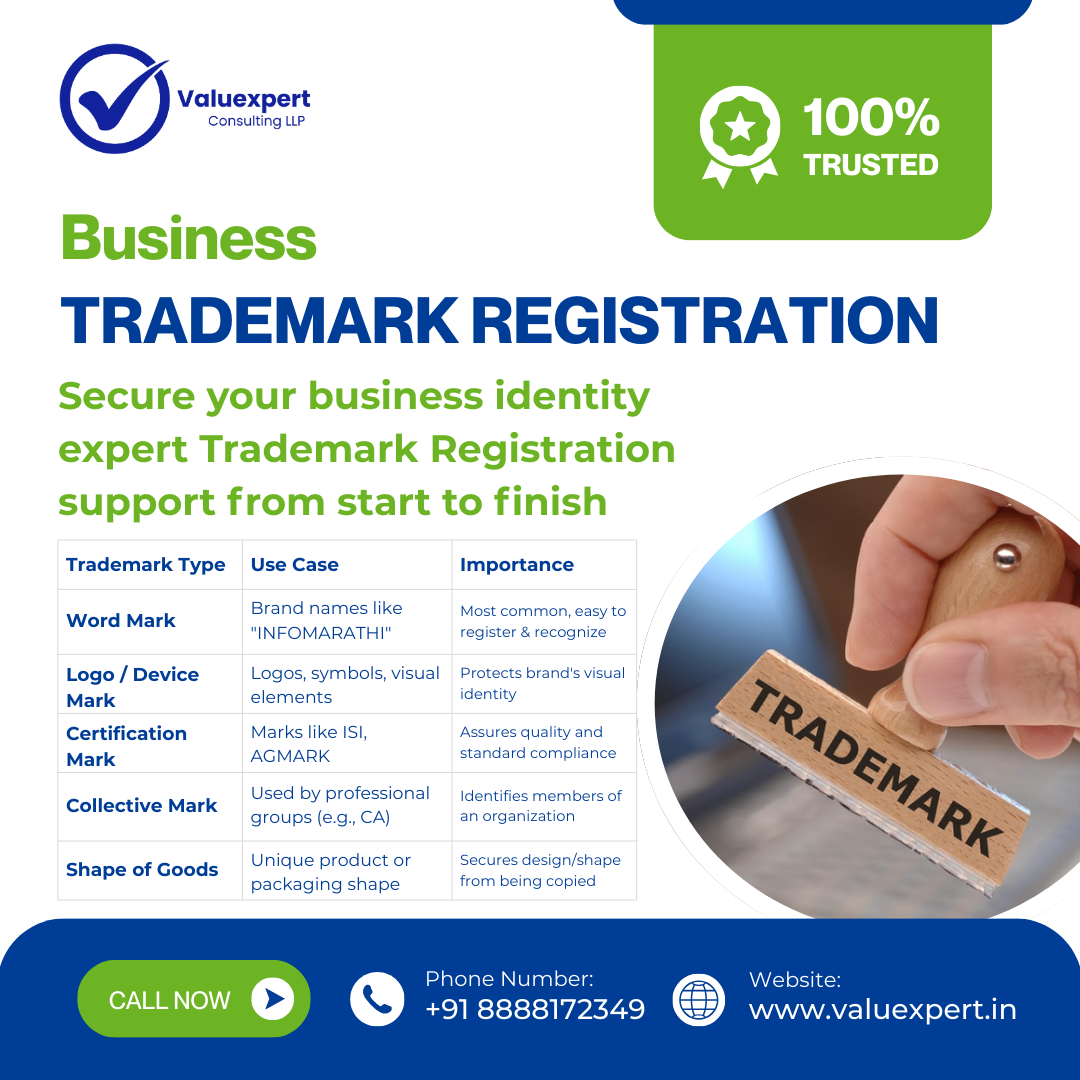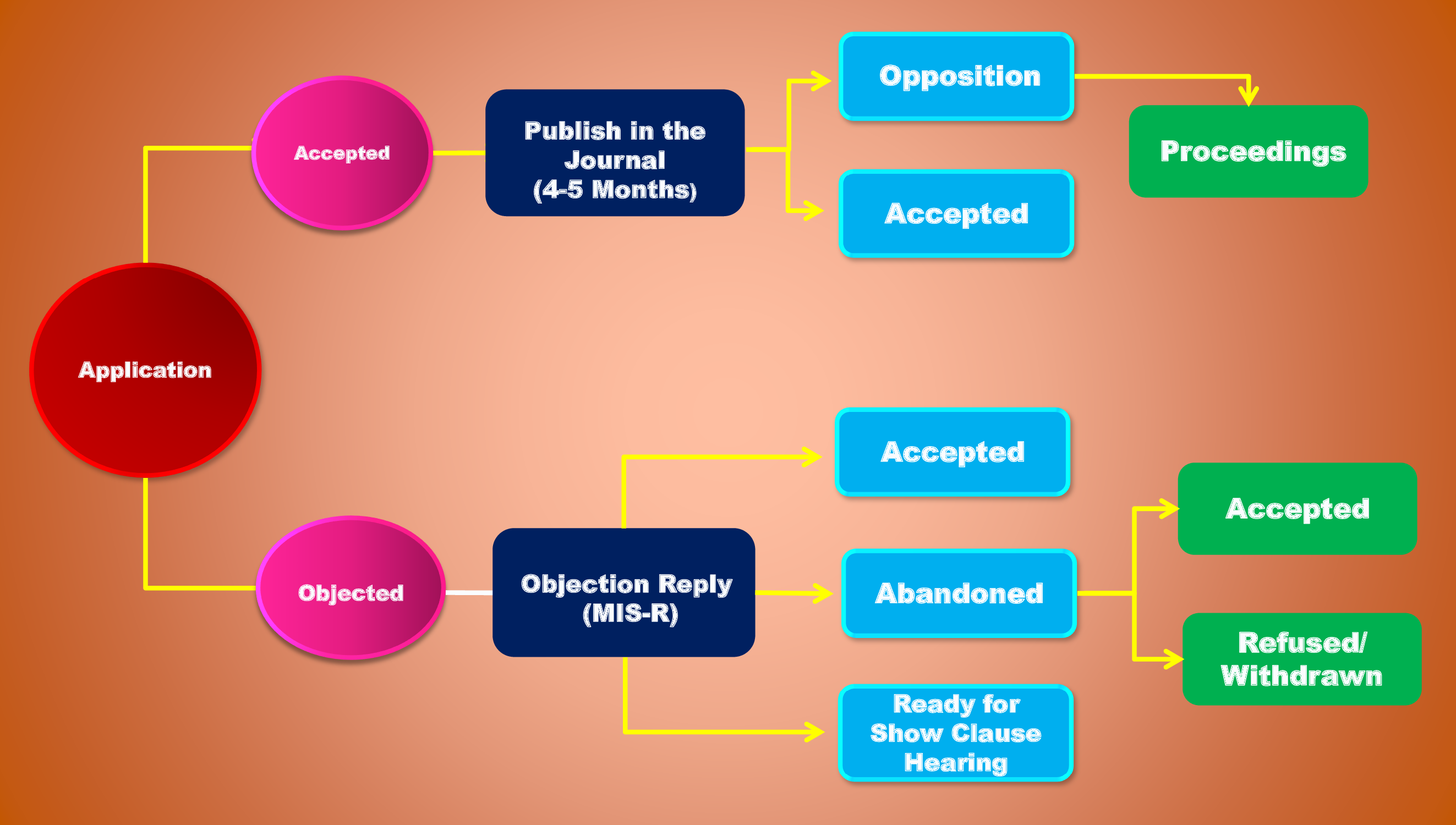Trademark Registration

No need to visit Trademark Register Office. Now, You can use the “TM” mark today.
What is Trademark?
Trademark is a unique identity such as name, symbol, letter, word, logos, shapes or mark or any other identifier that differentiates your product/ service in the market. A registered trademark is an invaluable asset to your business as it is used to protect your business brand. Registration ensures protection of your unique logo/ brand by restricting usage by other competitors as identical/ similar marks cannot be registered.
Trademark indicates that the trademark application has been filed with the authority and the registration is under process. After filling out the trademark application, an applicant can use the “TM” beside his brand name or logo and “TM” can be used until the trademark registration is done. After completion of trademark registration, the TM gets replaced by “®” which means the trademark registration is completed and Trademark owners have the right to use their mark exclusively for a period of 10 years from the date of registration.
With the help of experts at ValuExpert, you can easily register your trademark without any hassle.
Advantages of Registering Trademarks:
The following are the advantages of registering a Trademark:
1) Exclusive Right:
The registration of Trademark gives you the exclusive right to use of the registered trademark and indicate so by using next to your brand name.
2) Legal Protection:
The main advantage of registering trademarks is that your goods and services would have a unique identity and a brand name. The owners would have exclusive rights over the mark and would be able to take action or sue for damages in the case of unauthorized usage.
3) Asset Creation:
Registered trademarks may be bought, sold or leased just like any other asset attached to an individual/ company. It becomes part of the intellectual property that is owned by an individual/ company.
4) Brand Popularization:
A registered trademark will make it easier for customers to find your products in the market. It builds the reputation of your product and creates an identity which is unique from that of existing products in the market and thereby, acts as an effective commercial tool. The logo can represent the vision and individual characterisation of your company and products.
5) Goodwill:
Registered trademarks help in customer recognition and the extra earnings that follow because customers want to acquire your product due to increased recognition of your brand and name. Customers relate the quality of a product with its brand name, and this will help in attracting new customers as they will be able to differentiate the quality of a product by your logo or brand name.
6) Protection for 10 years:
Protection for 10 years: Every registered trademark is valid for 10 years and may be renewed for another 10 years with ease by merely filing a trademark renewal application. It is cost-efficient and helps your company create and maintain a unique image
7) Global Trademark Registration:
For any person willing to expand outside India, the trademark registered in India can provide a good base along with the Established goodwill in the Country.
Trademark Symbols:

Procedure/Steps for Trademark Registration:
1) Trademark Search:
Trademark search may be conducted on the government portal. whether any other person or business entity is not using the same trademark. Also make sure that there is no identical or similar trademark already registered or for which an application for registration has been submitted.
2) Filing of an application :
In this stage the registration by a person claiming to be the proprietor of a trademark, in the office of the Trade Mark Registry, within the territorial limits of the place of business in India. The applicant can file application through relevant form i.e. TM-A provided by trademark office/Registrar of Trademark. Also Trademark registration fees have to be submitting along with legal documents.
3) Examination of the application :
The concern authority keep this application for specific period of time to ascertain whether it is distinctive and does not conflict with existing registered or pending trademarks and after that examination report is issued.
4) Publication of the application :
If the trademark application is allowable, the trademark will be advertised in the Trade Marks Journal. Publication is done after or before acceptance of the application in the Trademark Journal.
5) Opposition by third party :
After publication objection can be raised by giving notice to the registration within three months which may be extended to the maximum of one month. To overcome the objection, the trademark holder needs to file a proper legal reply to the trademark registry in order to overcome the same.
6) Hearing before Registrar :
If the trademark is satisfied that the trademark request complies with all the necessary provisions under the act, the mark is advertised before acceptance.
7) Registration of Trademark :
If no opposition is received during the specified period, the Trademark is deemed to be registered in the name of applicant/owner. That means in this last stage after the registration of the Trademark the Registrar shall issue to the applicant a Trademark Registration Certificate.
Eligibility:
Any Person or Organization can make application for Trade mark Registration who owns it. The person can make application for Trade mark which he is going to use in future. However prior use of Trade mark in Business is always helpful.
Documents required for Trademark Registration:
1) Identity Proof of the individual.
2) Address proof of the individual.
3) Brand/logo/slogan name
4) Business Details
5) Udyam Certificate (If any)
6) Incorporation certificate (In case of a Company or LLP)
Process of trademark Registration:

Trademark Class List:
(Parts of an article or apparatus are, in general, classified with the actual article or apparatus, except where such parts constitute articles included in other classes).
a) Goods:
Class 1: Chemical used in industry, science, photography, agriculture, horticulture and forestry; unprocessed artificial resins, unprocessed plastics; manures; fire extinguishing compositions; tempering and soldering preparations; chemical substances for preserving foodstuffs; tanning substances; adhesive used in industry
Class 2: Paints, varnishes, lacquers; preservatives against rust and against deterioration of wood; colorants; mordents; raw natural resins; metals in foil and powder form for painters; decorators; printers and artists
Class 3: Bleaching preparations and other substances for laundry use; cleaning; polishing; scouring and abrasive preparations; soaps; perfumery, essential oils, cosmetics, hair lotions, dentifrices
Class 4: Industrial oils and greases; lubricants; dust absorbing, wetting and binding compositions; fuels(including motor spirit) and illuminates; candles, wicks
Class 5: Pharmaceutical, veterinary and sanitary preparations; dietetic substances adapted for medical use, food for babies; plasters, materials for dressings; materials for stopping teeth, dental wax; disinfectants; preparation for destroying vermin; fungicides, herbicides
Class 6: Common metals and their alloys; metal building materials; transportable buildings of metal; materials of metal for railway tracks; non-electric cables and wires of common metal; ironmongery, small items of metal hardware; pipes and tubes of metal; safes; goods of common metal not included in other classes; ores
Class 7: Machines and machine tools; motors and engines (except for land vehicles); machine coupling and transmission components (except for land vehicles); agricultural implements other than hand-operated; incubators for eggs
Class 8: Hand tools and implements (hand-operated); cutlery; side arms; razors
Class 9: Scientific, nautical, surveying, electric, photographic, cinematographic, optical, weighing, measuring, signalling, checking (supervision), life saving and teaching apparatus and instruments; apparatus for recording, transmission or reproduction of sound or images; magnetic data carriers, recording discs; automatic vending machines and mechanisms for coin-operated apparatus; cash registers, calculating machines, data processing equipment and computers; fire extinguishing apparatus
Class 10: Surgical, medical, dental and veterinary apparatus and instruments, artificial limbs, eyes and teeth; orthopaedic articles; suture materials
Class 11: Apparatus for lighting, heating, steam generating, cooking, refrigerating, drying ventilating, water supply and sanitary purposes
Class 12: Vehicles; apparatus for locomotion by land, air or water
Class 13: Firearms; ammunition and projectiles; explosives; fireworks
Class 14: Precious metals and their alloys and goods in precious metals or coated therewith, not included in other classes; jewellery, precious stones; horological and other chronometric instruments
Class 15: Musical instruments
Class 16 : Paper, cardboard and goods made from these materials, not included in other classes; printed matter; bookbinding material; photographs; stationery; adhesives for stationery or household purposes; artists' materials; paint brushes; typewriters and office requisites (except furniture); instructional and teaching material (except apparatus); plastic materials for packaging (not included in other classes); playing cards; printers' type; printing blocks
Class 17: Rubber, gutta percha, gum, asbestos, mica and goods made from these materials and not included in other classes; plastics in extruded form for use in manufacture; packing, stopping and insulating materials; flexible pipes, not of metal
Class 18: Leather and imitations of leather, and goods made of these materials and not included in other classes; animal skins, hides, trunks and travelling bags; umbrellas, parasols and walking sticks; whips, harness and saddler
Class 19: Building materials, (non-metallic), non-metallic rigid pipes for building; asphalt, pitch and bitumen; non-metallic transportable buildings; monuments, not of metal.
Class 20: Furniture, mirrors, picture frames; goods(not included in other classes) of wood, cork, reed, cane, wicker, horn, bone, ivory, whalebone, shell, amber, mother- of-pearl, meerschaum and substitutes for all these materials, or of plastics
Class 21: Household or kitchen utensils and containers(not of precious metal or coated therewith); combs and sponges; brushes(except paints brushes); brush making materials; articles for cleaning purposes; steelwool; unworked or semi-worked glass (except glass used in building); glassware, porcelain and earthenware not included in other classes
Class 22:. Ropes, string, nets, tents, awnings, tarpaulins, sails, sacks and bags (not included in other classes) padding and stuffing materials(except of rubber or plastics); raw fibrous textile materials
Class 23: Yarns and threads, for textile use
Class 24 : Textiles and textile goods, not included in other classes; bed and table covers.
Class 25: Clothing, footwear, headgear
Class 26: Lace and embroidery, ribbons and braid; buttons, hooks and eyes, pins and needles; artificial flowers
Class 27: Carpets, rugs, mats and matting, linoleum and other materials for covering existing floors; wall hangings(non-textile)
Class 28: Games and playthings, gymnastic and sporting articles not included in other classes; decorations for Christmas trees
Class 29: Meat, fish, poultry and game; meat extracts; preserved, dried and cooked fruits and vegetables; jellies, jams, fruit sauces; eggs, milk and milk products; edible oils and fats
Class 30:. Coffee, tea, cocoa, sugar, rice, tapioca, sago, artificial coffee; flour and preparations made from cereals, bread, pastry and confectionery, ices; honey, treacle; yeast, baking powder; salt, mustard; vinegar, sauces, (condiments); spices; ice
Class 31: Agricultural, horticultural and forestry products and grains not included in other classes; live animals; fresh fruits and vegetables; seeds, natural plants and flowers; foodstuffs for animals, malt
Class 32: Beers, mineral and aerated waters, and other non-alcoholic drinks; fruit drinks and fruit juices; syrups and other preparations for making beverages
Class 33: Alcoholic beverages(except beers)
b) Services:
Class 35: Advertising, business management, business administration, office functions.
Class 36: Insurance, financial affairs; monetary affairs; real estate affairs.
Class 37: Building construction; repair; installation services.
Class 38: Telecommunications.
Class 39: Transport; packaging and storage of goods; travel arrangement
Class 40: Treatment of materials
Class 41: Education; providing of training; entertainment; sporting and cultural activities.
Class 42: Scientific and technological services and research and design relating thereto; industrial analysis and research services; design and development of computer hardware and software.
Class 43: Services for providing food and drink; temporary accommodation.
Class 44: Medical services, veterinary services, hygienic and beauty care for human beings or animals; agriculture, horticulture and forestry services.
Class 45: Legal services; security services for the protection of property and individuals; personal and social services rendered by others to meet the needs of individuals.
